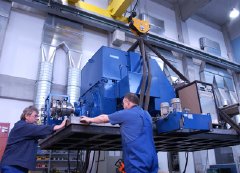Apr 17 2009
In Nuremberg the world’s first generator with coils made of high-temperature superconductors (HTS) has been running continuously for half a year without problems. Now, Siemens scientists are presenting the research and development project at the multi-party exhibition stand “SuperconductingCity” at the Hannover Trade Fair.

In the course of testing, the researchers from Siemens Corporate Technology, Marine Solutions and Large Drives used a transformer to synchronize the generator to the 20-kilovolt network of the Siemens site in Nuremberg. It supports the network there as a phase shifter by compensating for the reactive-power demand of other network users. One initial market for the generator is the field of offshore applications and marine vessels. Siemens researchers are currently also building an HTS propeller motor for this application.
Although high-temperature superconductivity was discovered more than 20 years ago, development of large rotary machines in the commercially relevant megawatt class is still relatively new. The term “high-temperature superconductivity” suggests heat, but it actually involves an operational temperature of minus 243 degrees Celsius, or 30 Kelvin. At this temperature, a current density of over 150 amperes per square millimeter (A/mm²) can be achieved in a high magnetic field. This is roughly 30 to 80 times greater than what is possible with copper coils at room temperature.
With such a high current density it is possible to build very compact HTS coils that are integrated into the rotor of a synchronous machine and operated with direct current. This technology represents a considerable improvement in efficiency – about 2 percent – and reduces the weight and volume of the whole machine. In addition, the coils stabilize the operational performance. And the real gain is that all these advantages can be realized at the same time in an HTS machine. By contrast, a conventional machine can only be made more efficient if more copper and iron is used, which makes it heavier. Compared with conventional equipment of even the same efficiency, an HTS machine is much lighter and more compact.In late 2005 the Siemens HTS generator with a rated output of four megawatts at 3,600 rpm was thoroughly tested for the first time. The HTS wires were developed and supplied by Bruker HTS GmbH of Alzenau, Germany. The generator is specified to comply with the regulations of the technical inspection company Germanischer Lloyd.
The generator’s weight and volume are 70 percent of the corresponding values for a typical conventional generator. At the same time, it has only half the losses, and the potential of this new technology has not yet been fully tapped. The machine has now been set up to run on an endurance test bed at the Nuremberg site of Siemens Industry Large Drives. Using a transformer, it is synchronized to the 20-kilovolt network and supplies reactive power of up to 2 MVAr, depending on the given requirement, and balances the demand of other reactive power consumers. On average, about 40 MVArh of reactive-power demand are thus compensated each day.
The HTS technology offers many benefits for modern shipbuilding and offshore applications. It will enable developers to design ships and platforms that are more energy-efficient and, because of the higher specific power density, better utilized. This reduces the impact on the environment and lowers operating costs. In addition, HTS machines are significantly quieter and operate much more smoothly than conventional generators.
The generator in continuous operation is currently being supplemented by another new development from Siemens — a slow-running HTS drive motor. The torque of this motor is 30 times greater than that of the generator. It is substantially smaller, lighter, and more economical than a conventional electric propeller motor. At the end of 2009 the developers want to put the machine through an intensive testing program in the test facility for large drives at the Dynamowerk Berlin. HTS generators and motors could become an element of the environmental portfolio of Siemens, which generated sales of 19 billion euros for the company in fiscal year 2008.
This research project is being supported by the German Federal Ministry of Economics and Technology.